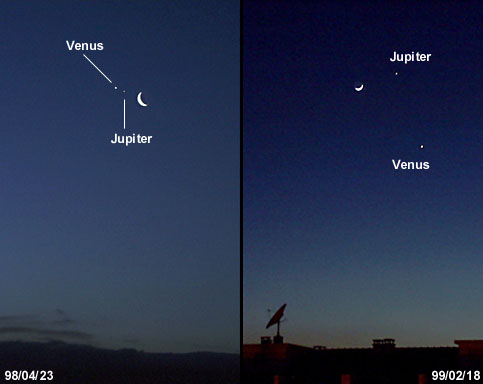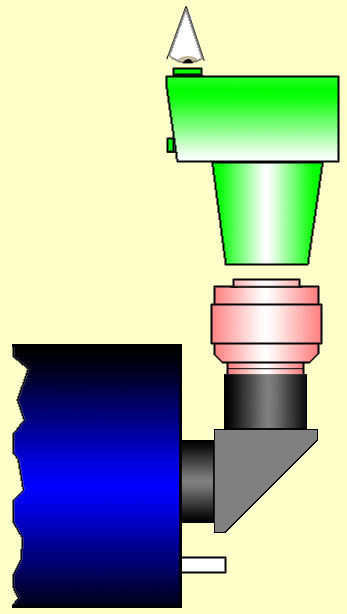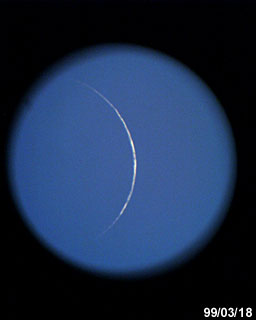


I bought the Olympus Camedia 1400L in the first place for domestic photography, and I'm still very happy with its performance. However, I soon realized that it could also be a nice camera for astrophotography, both as a stand-alone instrument and when used in combination with my 10" Schmidt-Cassegrain telescope. For a description of the camera's technical data I suggest a visit to the Olympus web-site. At this point I would only like to stress that the camera has various image-quality settings, and that I strongly recommend that the "SHQ" (super-high quality) mode is used. The highest resolution images (1280x1024 pixels) and the lowest JPEG compression will then be applied.


When mounted onto a simple photographic tripod, or just firmly held against a wall or window frame, the Camedia can produce nice twilight portraits of planetary alignments like that shown in the above left image, or of some interesting Moon-planetary conjunctions as those displayed in the above right images. In my opinion, the best results are obtained when the sky is still fairly bright, but simultaneously dark enough so that planets are already well visible. If it gets too dark, the image will result in just a few white dots isolated in a completely black frame, that is without the silhouette effect of some foreground buildings or the distant horizon. It is advisable to always obtain several shots of the same scene, playing a bit with the camera's zoom and with exposure compensation. Since the camera has an auto-focus mechanism that cannot be override, obtaining sharp images in low-light conditions can be difficult. I have always managed to overcome this problem by focusing onto the horizon, if the sky is sufficiently bright, or aiming at a distant street-light. If the shutter-button is only pushed half-way, the camera will obtain and maintain the necessary focus, and the correct image framing can then be chosen.


In my opinion, the most interesting use of the Olympus Camedia 1400L in the field of astrophotography is to grab color images of the whole moon disk. For that purpose, I use it in combination with my 10" f/10 Schmidt-Cassegrain telescope. Since the camera's objective cannot be removed, the setup I found most adequate is that presented in the above left drawing. The 10" LX200 optical tube is shown in blue, a 2" mirror diagonal is presented in black, a 50mm f/1.4 photographic objective is displayed in red, and the Camedia appears in green. The setup is just a typical "infinity-projection" or "afocal" system, in which the telescope's eyepiece is replaced by a fast 50mm photographic lens, with its diaphragm fully opened, and with its frontal element lens facing the mirror diagonal. The photographic objective I use (Pentax bayonet-K model) accepts 49mm filters, so its front side is very easily adapted to the 2" diagonal and may be firmly kept in place. The Camedia is then placed very close to the rear lens element of the photo objective. I have always maintained the camera "hand-held" for this purpose, with good results, but I admit that an improvised holder will also work just fine, perhaps even better. Before applying the Camedia, it is necessary to center and focus the object visually, just as if the photo lens was an eyepiece. Afterwards, the Camedia's auto-focus and auto-exposure capabilities will do the job. I never had difficulties in focusing the moon using this setup, providing that a part of its illuminated disk coincided with the central area of the viewfinder where readings are made. The same does not apply to the auto-exposure measurements. As expected, there was a tendency to obtain over-exposures when the moon was at a crescent phase. However, this could be completely rectified by using the camera's exposure compensation capabilities. Once again, as referred above, it is advisable to obtain various images with slightly different settings and preview the results in the camera's LCD screen.
The field-of-view provided by my setup is evident in the whole-frame image shown above right. This example depicts a very thin "baby-moon" crescent, obtained when the sky was still considerably bright. Heavy vigneting is obvious (it would not be if the sky was darker at the time), as is a useable field with a diameter that is not much larger than the moon's apparent diameter. Not much larger, true, but big enough to grab the whole disk of the moon providing that it is well centered with respect to the optic axis of the system. When the Camedia's lens is zoomed, vigneting almost disappears, but the magnification of the object will also increase and image brightness will decrease. Thus, in practice, a lower zooming factor gives better results. On one hand, there is no gain in field-of-view when we zoom (in fact, the opposite can occur). On the other hand, focusing will be easier with bright images, and exposure times will be shorter. Finally, the mega-pixel CCD of the Camedia 1400L (1280x1024 pixels in high resolution mode) provides sufficient resolution to get high-quality images even when only the central part of the frame is used.
I must stress that the field-of-view I get with my setup is only obtained because I use a fast f/1.4 photo lens in place of the telescope eyepiece. If the frontal lens of this photo objective had a smaller diameter (as occurs with slower lenses with higher f/D ratios), or if the lens diaphragm was not fully opened, only a fraction of the field would be obtained. That was the reason why I replaced the telescope's eyepiece with the photo lens in the first place.
The first half of a lunation is shown in these thumbnail images (click to download higher-resolution images), all obtained with the 10" LX200 and the Olympus Camedia 1400L, using the described "afocal" setup. Besides the modifications on shadows located near the terminator, the progression of lunar ray brightness is also obvious. Can you notice the different tints that characterize the various regions of the Moon?
The moon is not the only telescopic target for the Camedia. Photographs of bright stars, namely before or after being occulted by the moon (left), tight planetary conjunctions (center) or low-magnification planetary portraits (right) can also be obtained very easily.
In conclusion, I would say that the Olympus Camedia 1400L is not a camera model to buy specifically for astrophotography. As expected, the camera does not allow for long exposures (it is not refrigerated). Besides, it only has auto-focus and auto-exposure modes, the objective cannot be removed and there is always some degree of JPEG compression in the saved images. However, if we already own it for any other purposes, it would be a shame not to give it a try with bright celestial targets like the Moon, planets and some stars. At least for whole-disk moon shots, its performance is excellent.
All Images and Texts on these pages are Copyrighted.
It is strictly forbidden to use them (namely for inclusion in other web pages) without the written authorization of the author
© A.Cidadão (1999)